A news, a scam, a court judgement,
stories from a farmer, tribal, or fisher folk,
statements from political leaders….
these are the events that keep churning our
life each day. The same is true with me too.
Through my art, dreams negotiate with
the tensions of modern day living
stories from a farmer, tribal, or fisher folk,
statements from political leaders….
these are the events that keep churning our
life each day. The same is true with me too.
Through my art, dreams negotiate with
the tensions of modern day living
My time with Visthar (1991-2005) and close acquaintance with S.Kappen gave me frequent opportunities to connect with various marginalised communities such as tribals, farmers, fishworkers, and people who have been displaced by developmental projects, and to witness their struggles for their lives, livelihood, and identity. This has helped me to see the darker side of the mainstream discourses on Development, Economy, Dreams, and Success and to define my own choices in Art, Interventions, and Life.
Some of the designs shown below are used as posters, calendars, or picture postcards done in support of the struggles of the communities to which Visthar and myself were connected.
For me, being connected with these communities and becoming part of their struggles in my own limited ways was not just an act of support for them, but more importantly a struggle against my own fears of losing our Earth and a Vision of Life rooted in It, which I fondly nurture within. I found that it is the tribals, farmers, and fishworker's communities that are helping to nurture and protect the Earth with its rich biodiversity and a vision of life that is aligned with the speed and proportion of life.
Poster designed for the National Front for Adivasi Self Rule to be used for their campaign towards Adivasi Self Rule.


Artist Digento Kumar (a tribal artist from north east) and I jointly worked to conceive these two images to be used in a poster for the 3rd International Conference of the International Alliance of Indigenous – Tribal People of the Tropical Forests. We used earth, roots, and powder colors to create these images.

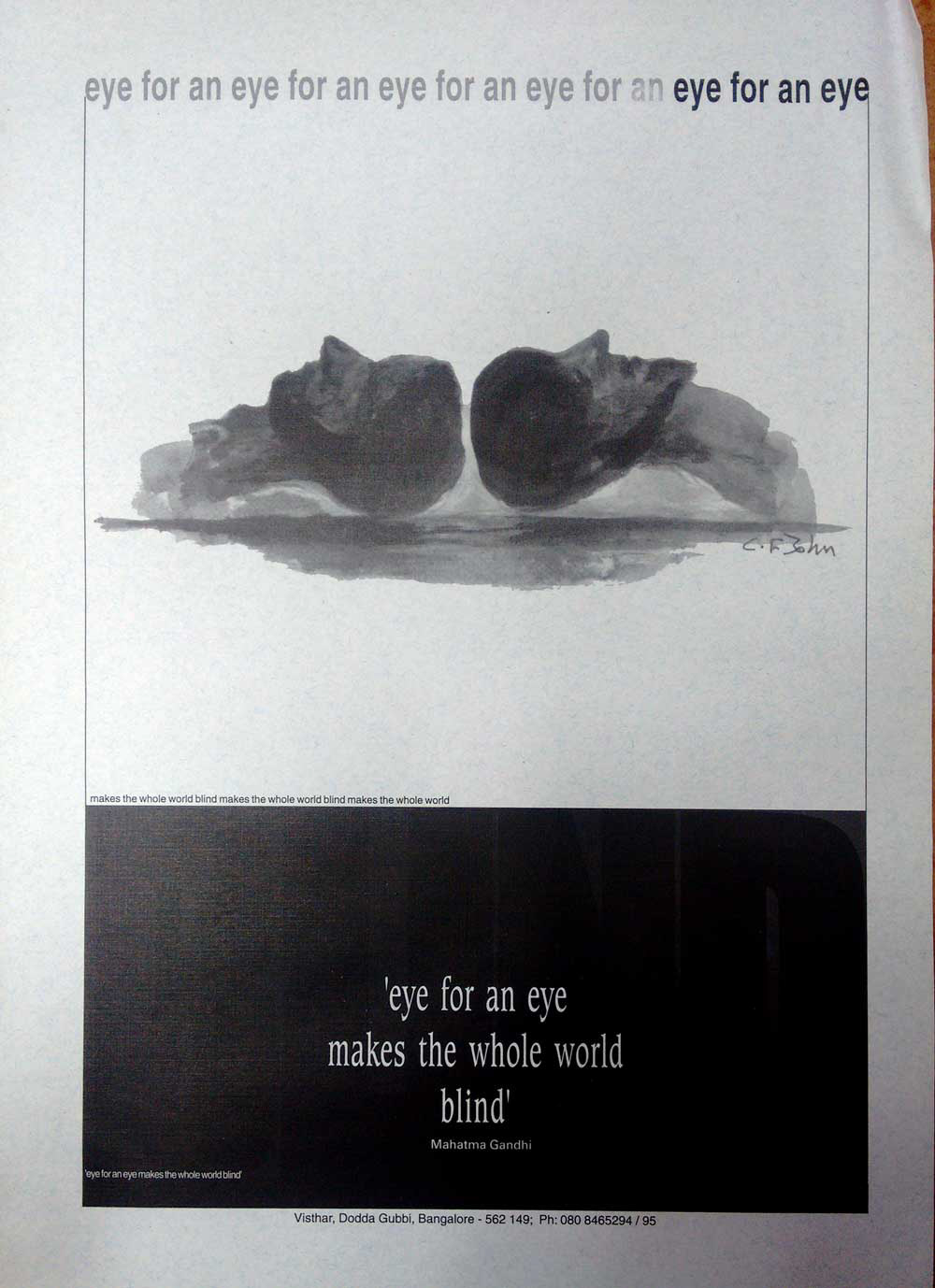


These are both from a series of posters designed to foster communal harmony and used by various initiatives in the country.


On 7 December 1992, the day after the demolition of the Babri Masjid, rather spontaneously I made this image. To my mind in those days I would not have agreed for myself an image of this kind, since it was a clichéd image. But the violence sparked after the incident somehow compelled me to make an image like this. It was an act of subconscious mind. Mercy and David of Visthar selected a quote from Kabir and printed this as a poster in couple day’s time. The response Visthar received from different parts of Karnataka was overwhelming. Certain district administrations in Karnataka asked for more copies for public use. The Bangalore police also used the same for the campaign fostering communal harmony. The posters were done in four languages: English, Kannada, Urdu, and Telugu.
Coming back to the use of clichéd images, like this one, I had my critical bias against certain other forms too. One among them was a popular song, "We Shall Overcome" , sung in those days during many protests. I felt it was hollow and did not resonate with it whenever I heard it. But some days after the demolition of the Babri Masjid, one evening, many people from different walks of life gathered at our usual place, Gandhi Park on MG Road. People held candles lit. During that gathering too, among many other songs, people sang “We Shall Overcome”. I saw tears rolling down from my years.

The idea was to emphasise the important role that women played in maintaining the order in a society and their active participation that keeps things in harmony. The thought revolved around the efforts of women in creating a society of justice.
This image was derived from the traditional folk style of art. The outer circle is a Wampum circle with fifty pendant strings made for the Confederacy of the 5 nations, the 1st step made by the North American Indians towards a settled nationhood. The story says that the coming of the White Man effectively destroyed it. This tool was a memonic, or a memory aiding device that was in the care of important tribal dignitaries who used to keep records of tribal history. The foundation of many of the tribes and the creation of their social institutions were ascribed by the Indians to mythical animals. The meaning in this particular image was re-interpreted to that of women being central to social togetherness, integrity and harmony. The image was a referrential product of the book New Larousse Encyclopedia of Mythology (Introduction by Robert Graves, published by Hamlyn: 18th impression-1984) This is an independent production by the artist. However, discussions were held to ideate the theme for Women’s Day that year. Each year, the organisation picks up certain relevant themes, inspired by the dominant political scenario of feminism at that point of time. The quote was subsequently chosen to best capture the essence of the image. Current condition: No more in circulation



This was used for a protest march after the murder of Shanker Guha Niyogy.
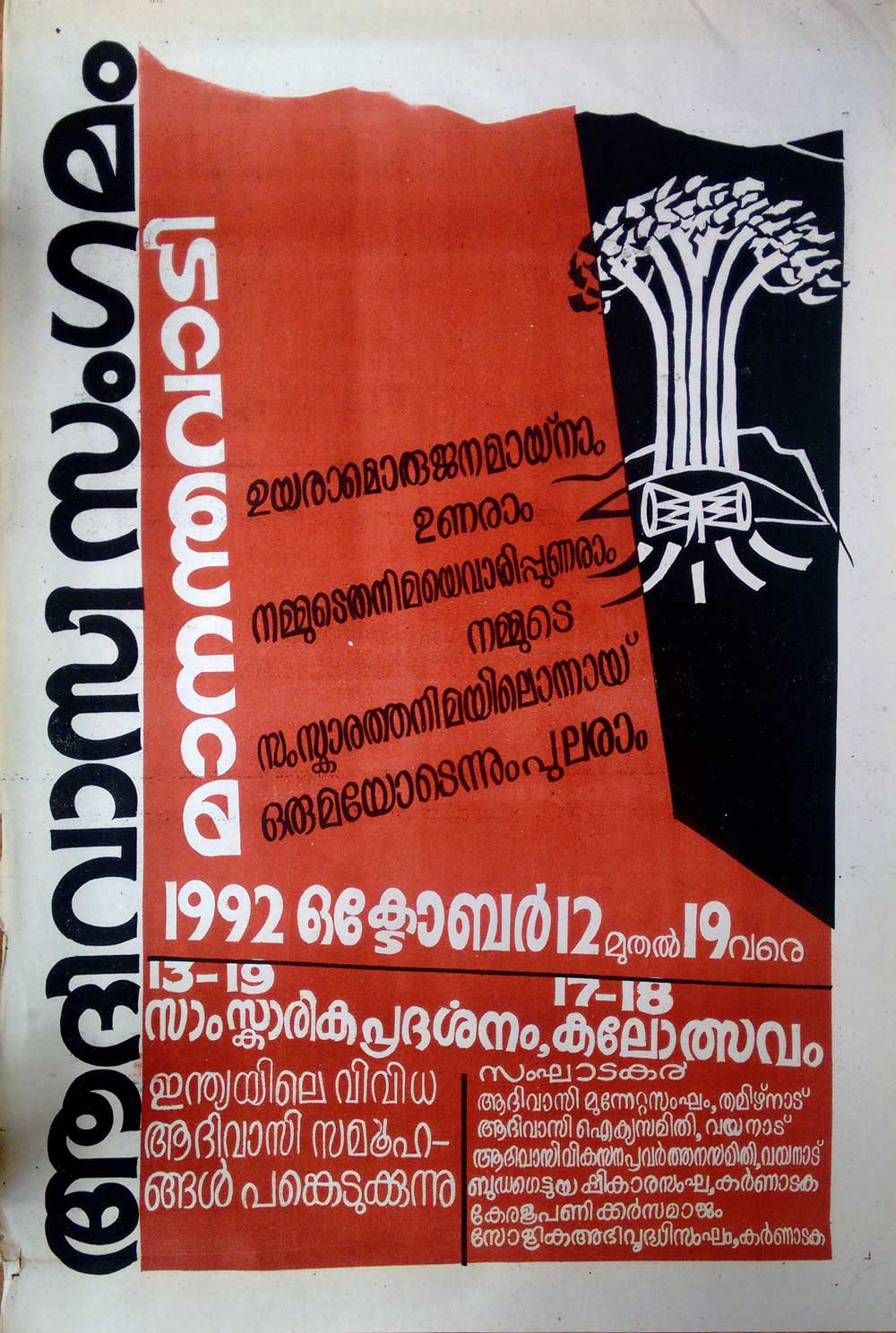
A poster for the campaign against liquor: A fight against liquor, A fight for Life.
Right poster: A poster designed for 'Adivasi Sangamam', a tribal convention, in October 1992. Over two thousand tribals from all over the country converged at Wayanad, Kerala. During this convention I also facilitated an art workshop for tribal youth on the theme "Tribal Vision of Land, Trees, and Water." They made paintings and drawings. In their drawings and paintings, in spite of the terror they faced with state institutions, the forest remained their home. They walked barefoot the land of abundance of Life, where trees stood like many breasted Mother Goddesses, branches adorned with honeycombs, nectar overflowing.


The organisers of a tribal convention approached me to do a logo for them. I was a bit apprehensive in the beginning. In an initial discussion on a possible image, the suggestion came of using a certain Warli motif. But I felt using Warli motives would be like what the tourism industry is doing to represent tribal or any other ethnic community. It is to stereotype and reduce them to some ‘looks pretty’ motifs. So instead I drew a tree withstanding a blowing wind, and a traditional bow and drum as part of its roots, representing the fight for survival and cultural identity. I was afraid whether the tribal leaders would accept it or would prefer the images that they were stereotyped with. But to my surprise and trust they immediately took it, saying it truly represented their life.






A series of interior posters did in the context of the World Social Forum.


A couple of posters designed in support of the 20 years of struggle by the victims of the Bhopal gas tragedy, 1984-2004. I used photographs taken by Raghu Rai to design these.



These are two pages from a calendar on ecological concerns that Visthar produced for the year 1997.
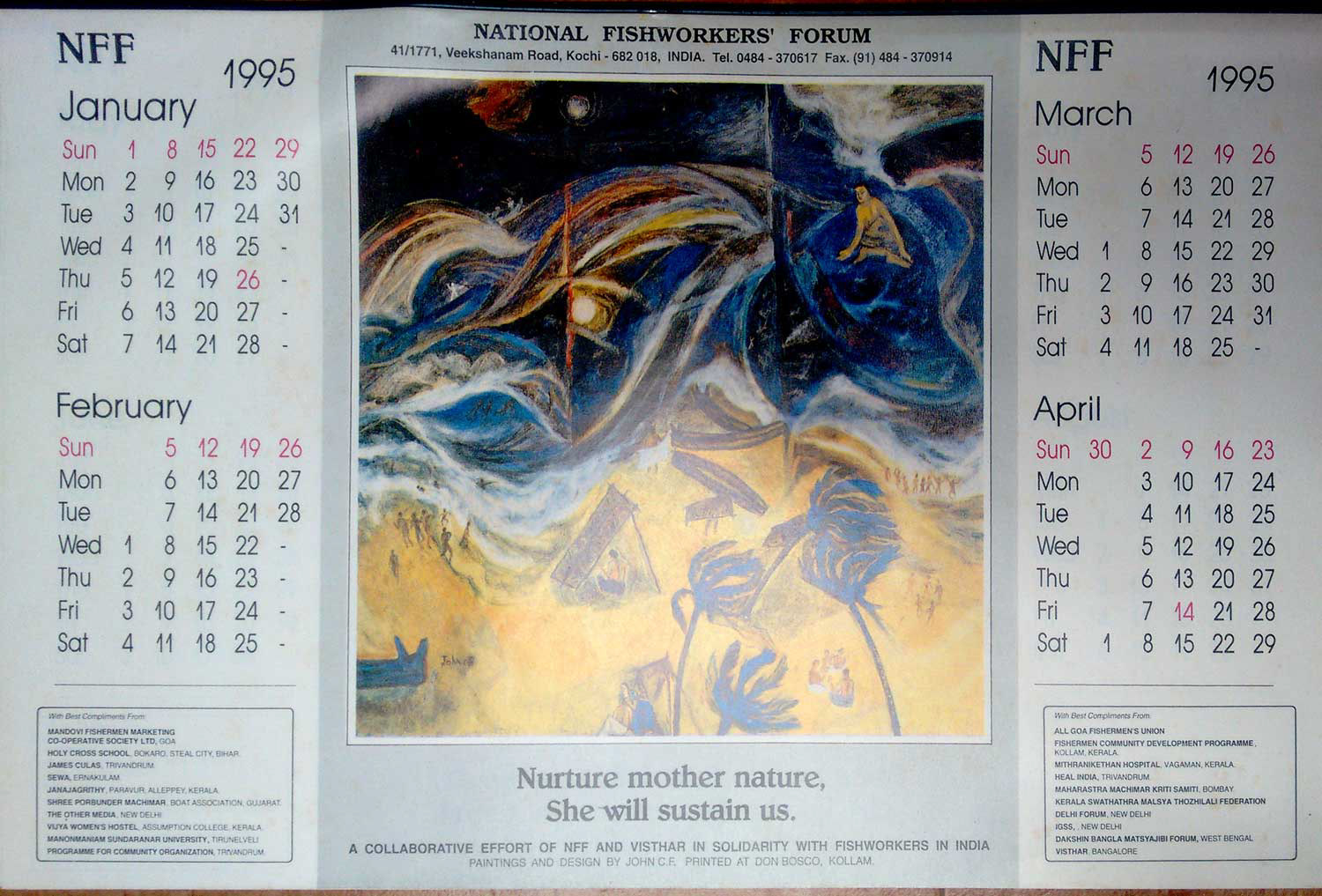


A calendar designed for the National Fishworkers Forum. The paintings were done after staying a week with a fishing community in Trivandrum, trying to understand what was central to their life. Three paintings that I made represented three themes. One focused on the regeneration and nurturing of the sea. The second one focused on coexistence with the forces of the sea. And the third was on their ongoing agitation against deep sea vessels.


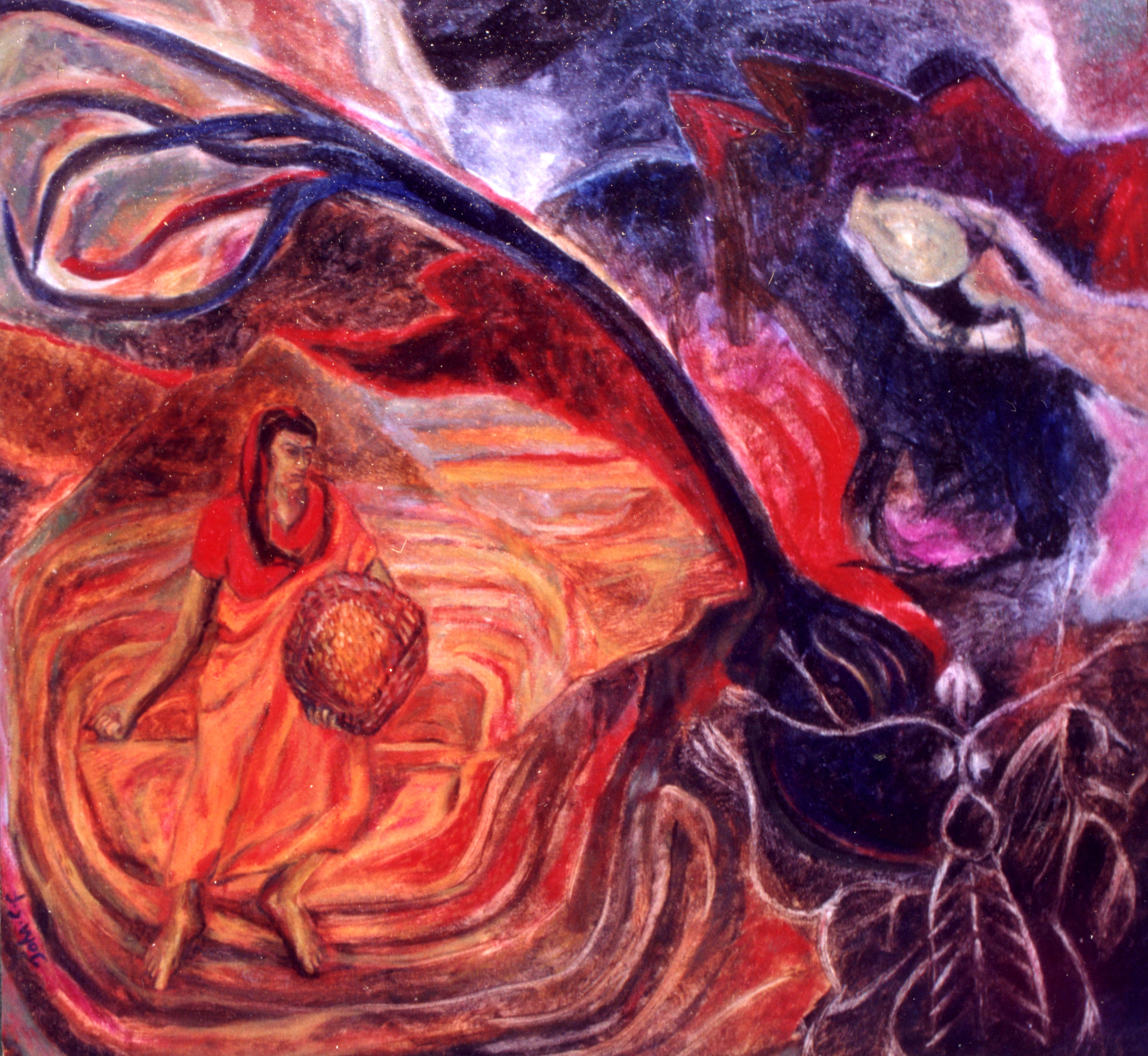
A calender produced using three paintings from a series of paintings that I did on the theme Celebrating Womankind. This was produced for the Coordination Unit of Beijing Conference, in the context of the Beijing International Women’s Conference held in 1995.
One of the painting was inspired by folklores in India and depicts the courage and solidarity of women. It emphasises on the positive, affirmative, strong aspects of a woman in the face of adversity where one supports the other. The two-women symbolizes togetherness in the face of adversity, and the boat moving towards the confluence of the river and the sea indicates the strength of women in their collectiveness to face challenges, and therefore their emotional strength, patience, and tolerance. The turbulent sea depicts violence and turmoil, and enhances the pictographic representation of the ability of women to move forward in time and space. The landscape is inspired by Indian folklore and depicts the turbulent times. The coiled body language, as of a child in a womb serves the dual purpose of portraying the flux of time captured within a woman and her insecurities.
The image for another page was women talking together through a tunnel, symbolising the coming of age of womanhood. It also refers to the dark times during which they are always together. The child symbolises the extension of support to the humankind that is greater than themselves. The image also depicts the role of a woman as a mother, signifying her greater contribution to the evolution of humanity and the constant cycle of life that is generated from within her. Thus it represents her all-encompassing nature in the creation of life. Earth tones were used in a unidirectional manner to depict her connection to Mother Earth. This represents the will of women to stay together unto freedom. (Text sourced from poster women archive)
The third painting focused on woman as a sower. In the painting she is both the Earth and sower at the same time. The earth is fiery red, ready to receive rain and seeds. Three motifs are used in the painting, She as Sower, as the Active Energy of the earth, and as the one who brings the Water of Life and Healing.

The painting and the calendar was designed in support of the construction workers union in Tamil Nadu.

Protect Earth Celebrate Life. An interior poster.
The idea behind the poster was to create a positive and affirmative image of women in social communication.
The painting was created after the Rio Summit. The caption was determined first. The idea was to celebrate earth. The painter at that point in time was greatly influenced by the Narmada Bachao Andolan and especially Medha Patkar in her active role as a transformer and protector of nature. The image of the woman is a reappropriation of the Greek mythic image, Goddess Isis, transformed as Medha Patkar. She symbolises the role of a woman as a protector of nature. Thus the idea of woman is superimposed with mother earth in the context of protection, equanimity, and nurture. The painting was initially produced as an interior poster and was later adopted for the title.
Other references: A South African Magazine reproduced the image while Zubaan books reproduced it on tee-shirts in Delhi (Text sourced from poster women archive)


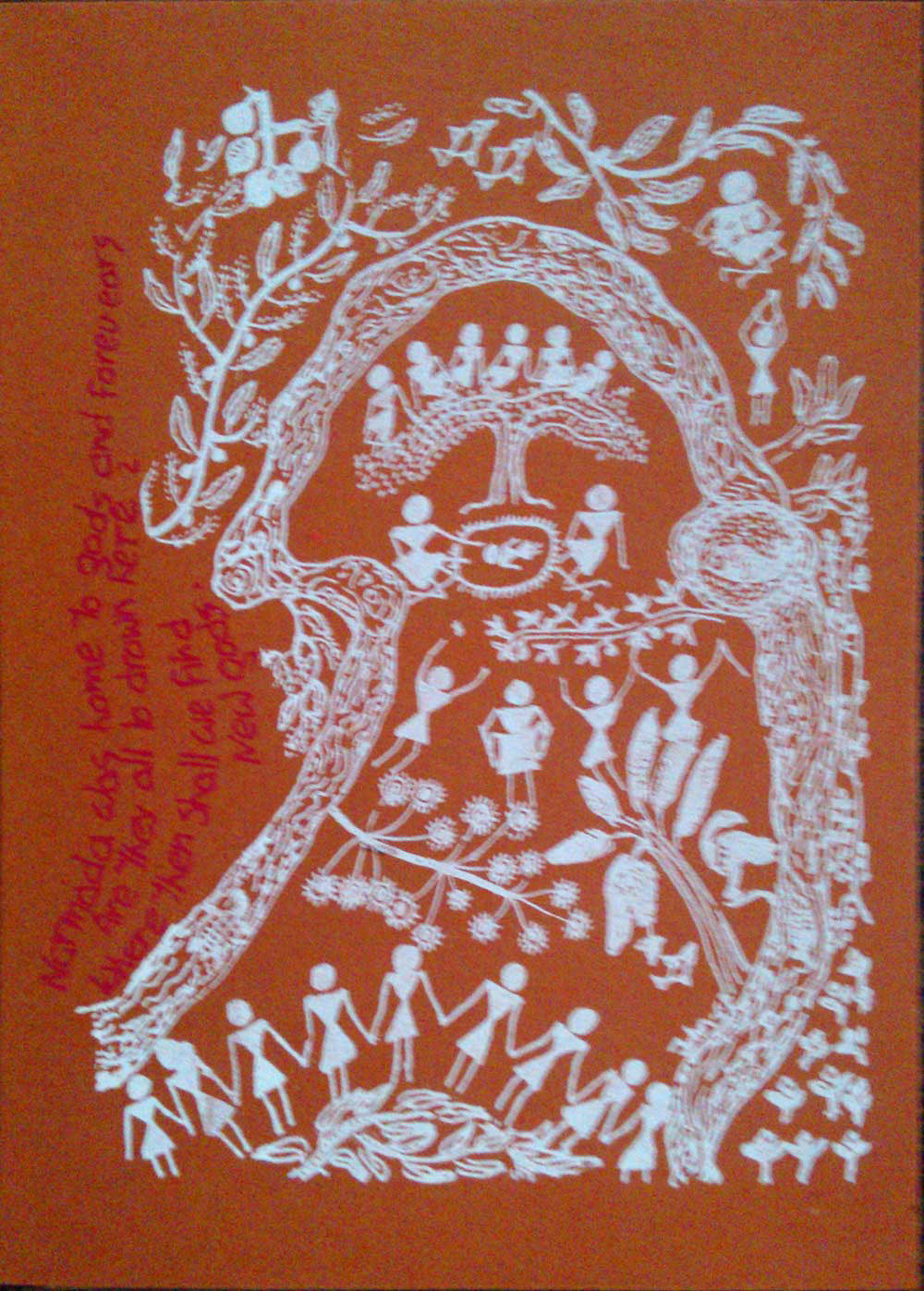




In 1991, I got an opportunity to visit the Narmada Valley and stayed for three days at Kasaravat village, where Baba Amte and his wife were living. It was a churning experience to spend time with Medha Patkar, Baba Amte, and the Tribals and Farmers who were protesting against the construction of the Sardar Sarovar Dam. During my time there I painted the walls of houses in the village, depicting major protests organised by the Narmada Bachao Andolan (NBA). So it was like creating an open album with images of their creative and evocative protests. I felt the protests organised by NBA had an evocative energy, maybe because of the Tribals and Farmers who are deeply connected with the river Narmada and her Land and Trees, and Medha being the guiding force. They together upheld a Holistic Vision of Life which defined the nature of their agitations. Their struggles were beyond a fight against what they were to lose, but upholding a vision for our common future, which is rooted in Earth and Life.
I felt making a documentation of the forms of protests done by the NBA would be a valuable documentation for all times, worldwide. Because their protests uphold a vision of life of abundance rooted in the earth, an economy of interdependence, an affirmation and proclamation of community in its true sense, not as of a club or sector, a spirituality that knows to honor the dignity of all, animate and inanimate, and a bargain not just for themselves but for our Common Good.
After returning from the Narmada valley, beyond other kinds of support demanded by the situations in their struggles through the years, I also designed a set of five postcards titled "Voice from Narmada Valley." We initially printed 200 copies, not knowing if they would make meaning to anyone. But they were received overwhelmingly. In the first few years we printed around two hundred thousand copies.